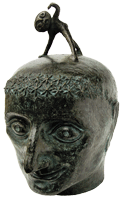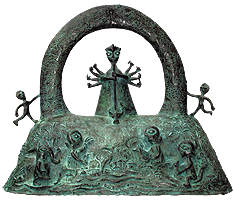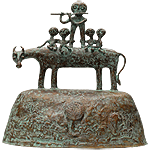- Prelude
- Guest Editor’s Column
- Creative Impulse
- Horloges : Counting The Hours
- Aesthetic Movement: Aesthetic furniture
- Book Review
- Engraving Deeper Thoughts:
- In the News
- Artist Index and Statistics
- Market Insight
- Auction Reports
- Photo Feature
- The month that was
- Mumbai Artsighting
- Art Bengaluru
- Musings from Chennai
- North-East Opsis
- In between – from Vadodara
- Deccan Odyssey
- Inscriptions in Bronze
- Writing Visuals
- A Missing History: The Other Story Re-visited
- Invisible Cities
- His Story
- Erasing Borders Exhibition of Contemporary Indian Art of the Diaspora
- Urban Testimonies
- The Medium Speaks Back
- Indian Art & Fashion goes to Sweden
- Mahanagar@Kolkata
- Different hues of Aakriti
- Christie’s : Important Watches Hong Kong
ART news & views
Engraving Deeper Thoughts:
Volume: 2 Issue No: 6 Month: 7 Year: 2010
Sculpture-making is the manifestation of the creative energy that allows the artist to evolve through a process of procreation. It is more like giving birth to something through the concentration of creative energy that in the words of  William Blake is “Energy is Eternal Delight”. The passion behind sculpting and the joy of procreation combined together have always led to certain kind of innovation associated with sculpture-making. It is not only in the thought process but also in the nature of handling mediums till the method of execution that sculpting in generated through innovation, be conventional or avant-garde. Thus the art of sculpture is one of the most conceptual and ideational discourse of aesthetics where sculptors have remained engaged in experimenting with techniques, materials and mediums. And in our contemporary times, this form of art has emerged as an amalgamation of various art forms being executed with a much broader connotation and new syntax with globalization at the backdrop.
William Blake is “Energy is Eternal Delight”. The passion behind sculpting and the joy of procreation combined together have always led to certain kind of innovation associated with sculpture-making. It is not only in the thought process but also in the nature of handling mediums till the method of execution that sculpting in generated through innovation, be conventional or avant-garde. Thus the art of sculpture is one of the most conceptual and ideational discourse of aesthetics where sculptors have remained engaged in experimenting with techniques, materials and mediums. And in our contemporary times, this form of art has emerged as an amalgamation of various art forms being executed with a much broader connotation and new syntax with globalization at the backdrop.
For Subrata Biswas, the joy of procreation and sculpting is somewhat formulated through a middle-way path, if not breaking the conventional discourse of this art practice, definitely he does not withstand those  conventional parameters as well. Subrata's preference of medium is metal and specifically bronze for the nature and properties of this metal. He puts it this way, “Metal-casting is one of the most flexible ways of conveying thoughts. It can be given a shape as you want to give it and moreover I have eventually experimented with this medium over a passage of time that gives me enough comfort to be with it in perpetuating my creative discourse.” And Subrata actually creates a difference in the use of this medium as a formulation of a new genre in the form of ideas that are given birth through this art form and art medium. At the concept level as well, he attempts to create a balance between traditional art symbol and modern day cult with a fine tuning blended against each other.
conventional parameters as well. Subrata's preference of medium is metal and specifically bronze for the nature and properties of this metal. He puts it this way, “Metal-casting is one of the most flexible ways of conveying thoughts. It can be given a shape as you want to give it and moreover I have eventually experimented with this medium over a passage of time that gives me enough comfort to be with it in perpetuating my creative discourse.” And Subrata actually creates a difference in the use of this medium as a formulation of a new genre in the form of ideas that are given birth through this art form and art medium. At the concept level as well, he attempts to create a balance between traditional art symbol and modern day cult with a fine tuning blended against each other.
The concentration of Subrata Biswas's works is the formal pattern of casting bronze that conceptually deals with tales from Indian mythology with a blend of folk culture. Different protagonists of the medieval folk tales and heroes blended  with divine powers also become the protagonist of the tale, Subrata engages to create. There is a unique way of contextualizing as well as situating these folklores in the modern, present context which allows the artist's works to set up a different denomination. For the sculptor, looking back into deep rooted indigenous culture is one part of his creative journey to recreate his subjects. But this has to be considered as the bigger canvas of the thought-process where again and again Subrata picks up stories and characters from the folk tales and myths. When asked, he gives a much intensive self-reflexive answer to depict the source or inspiration of his subjects in the sculptures he creates. He says, “The rural life intrigues me a lot and I don't even belong to a so-called urban culture. So, folk is an integral part of my life. With changing times, the contexts, realities and way of seeing things have evolved for me and confronting with those aspects in day-to-day life becomes at times a factor of disillusionment. To seek refuge I often take shelter in the world of my childhood memories. Nostalgias help me to rejuvenate my innocence and the reflex can be observed in my works. It is not just an attempt to
with divine powers also become the protagonist of the tale, Subrata engages to create. There is a unique way of contextualizing as well as situating these folklores in the modern, present context which allows the artist's works to set up a different denomination. For the sculptor, looking back into deep rooted indigenous culture is one part of his creative journey to recreate his subjects. But this has to be considered as the bigger canvas of the thought-process where again and again Subrata picks up stories and characters from the folk tales and myths. When asked, he gives a much intensive self-reflexive answer to depict the source or inspiration of his subjects in the sculptures he creates. He says, “The rural life intrigues me a lot and I don't even belong to a so-called urban culture. So, folk is an integral part of my life. With changing times, the contexts, realities and way of seeing things have evolved for me and confronting with those aspects in day-to-day life becomes at times a factor of disillusionment. To seek refuge I often take shelter in the world of my childhood memories. Nostalgias help me to rejuvenate my innocence and the reflex can be observed in my works. It is not just an attempt to  re-focus or glorify the folk tradition as a part of my aesthetic propagation but much to do with my personal philosophy in the form of intimate memories with time spent in the lap of nature.” It is quite evident that Subrata's works have an in-built rustic quality and a naïve exploration of thoughts. And the artist devises his conceptual discourse in such a way that makes his works more provocative and open-ended to be explored.
re-focus or glorify the folk tradition as a part of my aesthetic propagation but much to do with my personal philosophy in the form of intimate memories with time spent in the lap of nature.” It is quite evident that Subrata's works have an in-built rustic quality and a naïve exploration of thoughts. And the artist devises his conceptual discourse in such a way that makes his works more provocative and open-ended to be explored.
Subrata's works don't give the audience an immediate jerk at its first sight. The work of art embraces its viewers to takes them within the space to develop a mood for the viewership. Slowly but steadily the layers of intense thoughts comprising of broader connotations of culture and conflict with contextual realities get disclosed. The whole process of deciphering meanings step-by-step is also a journey for the viewer that the artist attempts to relate with his own journey of creation.  In this way the mechanism of reciprocation becomes much passionate and avid.
In this way the mechanism of reciprocation becomes much passionate and avid.
What makes Subrata's trademark is also the most intriguing aspect of his works that is the engraving style he applies on wide bronze plates may be the base of any sculpture quite alike the engraved seals of the ancient civilizations. At the level of execution, the style personalized by Subrata not only remains an innovation in the formal development of the art of sculpting but also lets out the performance of a cerebral exercise that invites the sensible audience to respond towards a serious discourse. This dynamism in conceptualization and in the art of making has eventually allowed making Subrata Biswas's sculptures distinct in the art world. In the years to come we hope to see Subrata curving a further eclectic vision with his qualitative identity in the creation of his artworks.
Sarmistha Maiti